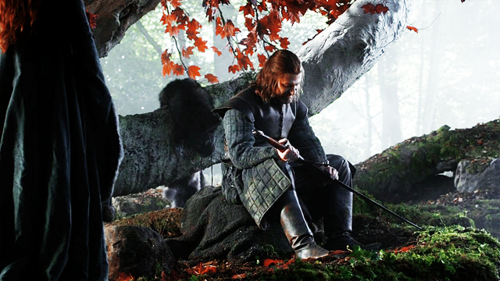
The Game of Thrones is now showing on HBO. The production and promotion of this series has been fantastic, but not everyone tuning in may be familiar with the series of books upon which it is based. A Song of Ice and Fire, currently spanning four expansive novels, introduced us to the world of Westros and provides a plethora of extensive information. Presented here is a bit of that information to help newcomers to this lush and living world get and keep their bearings. All information is presented free of spoilers and describe the circumstances at the beginning of the series…
The Seven Kingdoms of the Andals have endured for thousands of years. Their peoples have often turned to forces of creation and destruction for guidance and inspiration. Faiths old and new mix throughout the Seven Kingdoms and the gods of foreign lands also linger on the fringes of the world, not as well-known but just as powerful. What follows is a brief look at the principle faiths of the Kingdoms and one or two gods of note whose power resides across the Narrow Sea.
The Old Gods
When the First Men came to the Westeros, they tried to drive out the spirits of the forest worshiped by the natives. They failed, and as part of the peace they sought with the children of the forest, they pledged to cut down no more weirwoods, large trees bearing the faces of those same spirits. When the Andals came, they called these spirits the Old Gods. As kings came and went and long after Aegon the Conqueror brought the Seven Kingdoms to heel under his rule, the godswoods remained, an indelible reminder of the roots of many noble Houses. Faith in the Seven has replaced the respect and worship given to the Old Gods, but in the North, the House of Stark, many of its sworn bannermen and the men of the Night’s Watch hold their prayers and swear their oaths in the godswood among the roots of the heart tree.
The Seven
Quickly becoming the largest faith in the Seven Kingdoms, the Seven are worshiped in buildings called septs, ranging in size from small houses to lavish structures rivaling the halls of great keeps like Casterly Rock and the Red Keep of King’s Landing. Septons guide the faithful’s prayers and take their donations. Each sept includes a representation of each god making up the Seven: the Maiden, the Father, the Mother, the Warrior, the Smith, the Crone and the Stranger. The septons tend to act as advisers to lords and knights in the manner of maesters, and while militant branches of the faith have existed in the past, the edicts of previous kings have kept these branches confined to the pages of history and the stories told by the faithful who feel powerless before the changes that sweep through the Kingdoms.
The Drowned God
Worshiped exclusively on the Iron Islands, the Drowned God is said to lurk in the darkest depths of the sea. While not as well-known as the Seven, the Drowned God has no less influence given the part it plays in the ways and means of House Greyjoy. It is said that only one whose faith in the Drowned God is unquestionable may sit the Seastone Chair that is occupied by the leader of the Iron Men. While the pirates and reavers of the Isles would not admit it, the Drowned God and its drowned faithful are something of a frightening presence. Fearless and wild, they go into the sea normal men and come out quite different. They drink seawater, eschew ostentatious trappings and murmur the words of their faith: What is dead can never die but rises again, harder and stronger.
Lord of Fire
From across the Narrow Sea come the red priests and priestesses of R’hllor. They call him Lord of Light, the Heart of Fire, and the God of Flame and Shadow. His is a faith that has not taken much hold in Westeros, but with darkness seeping into the world with the coming of winter, his time may soon be approaching.
If you would like to know more, please consult the official HBO viewer’s guide or the Wiki of Ice and Fire (beware of spoilers). Also, if you find anything amiss or incorrect in these guides, please inform me.



Leave a Reply